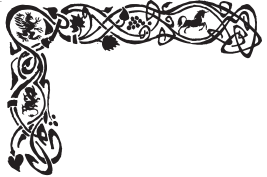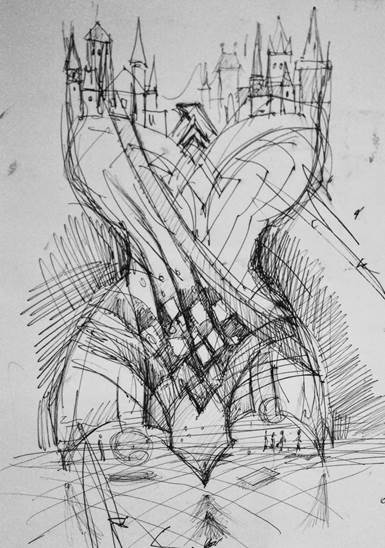
The Human Hourglass (sketch) – Wonder Woman in WWI - historical romance bleeds into parallel realities
These ancient battles, and Howard’s retellings, are in another universe to our one of temporal capitals (nudge, nudge). Jerusalem as the symbol of spiritual freedom from temporal tyranny is ageless and basically matches the Cross to the Crescent in a symbiosis of faith. Jerusalem is a physical place with a spiritual dimension. Ever the two meet, whereas in our own world the proportionate sense of reason and pleasure – the soul of the human figure – is sadly lacking. Lacking for a reason; “they” want it so.
LAND O’FREELOVE AND GOODBYE
Howard’s world is neither reason nor pleasure but more like a dream – a dream of reckless gaiety, of the psyche and of figures in a landscape. Power (onotolgy) and meaning (epistemology). The dream is the superpower of nature, where winter lies underground and gaiety is in the air.
We are in the world of belief – whether Cross or Crescent – where neither reason nor pleasure have dominion. Legends hold sway. That world is proportionate between the psyche and emblematic form.
When you see “the rivers ever flowing” you are blessed by powerful spirits. This land of free simplicity is ever-hidden from the mind of modern Man by the struggle to resolve facts into a transformative maze. There is no struggle where one is born into nature; where one has the glory of matriarchy (the lofty aerie Pictorial 5). This is the land of symbols, legends and iconic form born not of reason but of psychic strength. The land that is proportionate has grace and clarity and gives strength to limb and mind.
An iron man in an age of iron, he added to his physical ruggedness a dynamic nerve-energy that carried him beyond himself and upheld him after more stolid men had dropped by the wayaide. (page 269)
That world of ambiguous conflict but shared beliefs is well described in Howard’s tale of the sack of Jerusalem. Men cried on Jehovah and Allah, and some prophesied a miracle that should deliver the Holy City. But in the merciless blue sky no flaming sword appeared.. (page 270). No legendary swords maybe, but in the Holy City spirit and matter meet in iconic form. The ages of faith were one of independent Christian city-states where architecture was an aspect of the ideal figure, an ideal symbolised by Jerusalem.
There is an ambiguity in this state where everything from a Crusader fort to a city is self-governing and free to defend itself. The same ambiguity you find between men and women, between feuding individuals.
The assumption since circa WWI is we’re better off to be the same but there is a spiritual aspect to self-sufficiency. Sameness, in actual fact, leads inevitably to a parallel reality of “effect” – reward, or reason applied to pleasure – and is toxic to the universal psyche. In Pictorial 9 the $ is the symbol of this, which I realize is a very provocative statement. The point is, that is the dollar of a transformative maze; it’s not the US dollar of old, it’s a Martian counterfeit. Going back in time – and through Howard’s tales – it’s so obvious money per se is vastly less important than grand opulence - where the material world meets the spiritual one of faith and divine rule.
In Howard’s story, the Masked Knight on a pilgrimage to Jerusalem with “only one faithful servitor”, a great Dane (not the hound), is finally revealed to Red Cahil as the woman who betrayed him and now seeks penance. The scene is very moving, coming at the end of the final battle for Outremer and the time-worn Christian orders’ heroic last stand, and you sense with Haroun (Baibars the Turkish warlord of Egypt), that they are “relics of an outworn age” (page 281)
Both die but Baibars is greviously wounded, and proclaims, “in a year or a thousand years they will trample Islam under their feet and ride again through the streets of Jerusalem.”
This is the tale of the ending of Outremer as a great knightly destination steeped in romance, and Howard gets the essential ambiguity of those end-of-days nicely. The Sieur Renault is reduced to scavenging off caravanserai in his isolated stronghold of loyal retainers. The essential weirdness of the Outremer world of material poverty and spiritual profundity must have appealed to Howard and, if you add his dreamlike sequence of the old malik meeting his lost love at death’s door on the end-of-days battlefield, it is as close to fantasy in a realistic setting as you’ll get.
What Outremer seems to represent is a place where spirit takes material form, and differences are of paramount importance. The standards, the Holy Cross, the Orders. It seems to be the most blatant case of an idea being stronger than material goods, and even as the first America! - somewhere that attracts knight and retainers of no great wealth but great vision and resilience.
There is also a certain fantastical, outlandish element that must have attracted Howard’s fantasy soul and eye for different races and faiths gathered together. Outremer is a land of spirit where differences flourish, so I think there is a type of connection with the early America.
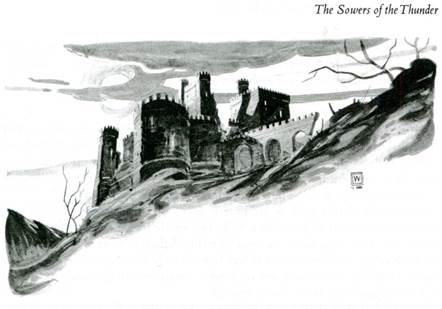
John Watkiss
If you say, then, that spirit is reality of a slightly weird order, the corollary is that material wealth is not real in the same sense. In relatively poverty-stricken cases like Outremer it’s real enough but, where you have material goods and little else, it’s essentially a parallel reality of “effect” (and little more).
I think the idea of a reality that is spiritually charged runs through Howard’s historical yarns, and is why they read like fables. The honest simplicity of the characters is striking, and often their very different origins that are linked to a common cause. What that could imply is that sameness is actually deadness of spirit, whereas differences have an affinity of spirit.
The Shadow of the Vulture, taking place 150 or so years later, has several characters of that type, and is one of Howard’s best tales of self-sufficiency against intolerable odds. It starts with his knight errant Gottfried von Kalmbach at the magnificently opulent court of Suleyman and, when he quits the departing envoys, he flings off the parting line,
Now I have two hundred ducats and these robes which I can sell to any Jew for a handful of silver, and may the devil bite me if I draw sword for any man while I have a penny left. (page 392)
Of course he’s chased to the walls of Vienna by one Mikhal Oglu and the long siege begins. An independent city of Christendom against the massed ranks of the Grand Turk. Before embarking on the narrative, though, it’s worth remembering that in Christendom material wealth is opposed to spirit. The thing about spirit is it’s not normal, it’s a legendary narrative full of beards and God’s wounds. The super-normal is reality and money is simply mundane matter. Jewish moneylenders are pragmatists and collectors of fine wines in this story; it’s completely not an ideology.
In other words, it’s exactly the other way round to what “they” tell us. Reality is only mundane if the bizarre spiritual reality is deemed to be unreal. That’s why the $ is such a powerful symbol in the modern world; it monetizes reality (distorts it) and you are then in a parallel reality. Howard, even in his historical narratives, has a nice sense of the bizarre and otherworldly ostentation that is not just material but has an aura of fascinating, ageless spirit.
We are living in a parallel world, friends, so allow me to take you back to days of yore when men were men and women were women. In a physical sense, when Russian mercenary Red Sonya of Rogatino cavorts onto the stage, Howard spends inordinate length on her bizarre apparel. It’s practically fetishistic, particularly when you add her vow of chastity (taken-up by the comic book Red Sonja).
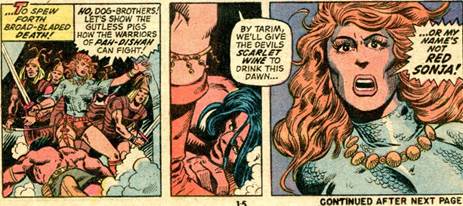
Conan 23 © Marvel 1971
The utilitarian coarseness of women’s ware to allow free-flowing movement – be it peasant, warrior or aristo – is something mentioned with regard to Wonder Woman (And God Created). There’s a bondage aspect to such garb – “love-binding” – which I think Howard often accentuates with lines like, Gottfried approached, eying in open admiration the splendid swell of her bosom beneath the pliant mail, the curves of her ample hips and rounded limbs. (page 402)
The body of a warrior-woman is both accentuated and given very free access to coordinated movements, with baggy breeches and ostentatious capes, dirk or sword quick to hand. The fantastic appeal of all this to men is super-obvious, so it is almost a superpower of feminine nature that you are seeing. In the comic version of the story BWS draws a loose chainmail shirt that accentuates her figure.
So, where is all this leading? That a woman-in-action wears utilitarian costume that accentuates her figure while allowing her free movement. In Millet’s painting of mid-19th century peasants, Angelus, the woman wears a tightly-bound, free-flowing garment.
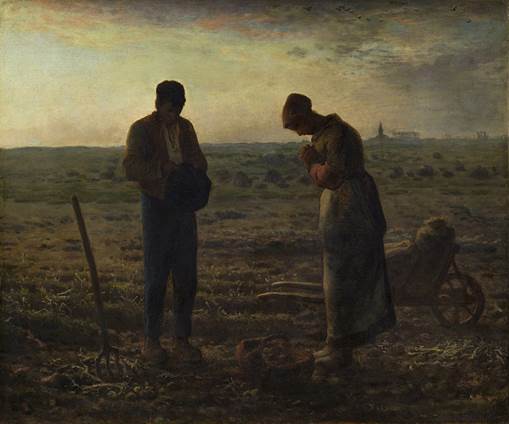
You could say there is a fetishistic aspect that enhances sexual differences. Where women are active this is always going to be so; there is showjumping gear, for example. It’s purely utilitarian or pragmatic, and even more so where you have warrior women or wearing plate-armour a la Wonder Woman. So, if women are active and want to be comfortable, they will wear clothes that accentuate their figures in a somewhat provocative fashion (you might call it a Weird Tales or Crumb-like fashion!)
This is what I would call reality, if you go back to olden times (Puritan settlements a la Indian Summer – see Outtakes 7), medieval or Biblical. It’s a physical allure and strength and alongside it goes chasteness or physically a chastity-belt. It’s because we live in a parallel world that is highly monetized that we may not realize what we have lost physically. Since, basically, there are far fewer peasants, horseriders and so forth. The last flowering of maidenly virtue was probably the Summer of Love in San Fran (67/68) which you can see on the Woodstock DVD.
With physical allure there is a psychic strength since both have to go together; body/mind. That is what we have lost in our parallel reality of “effect” that is reason (dollar $) applied to pleasure (goods).
Home
